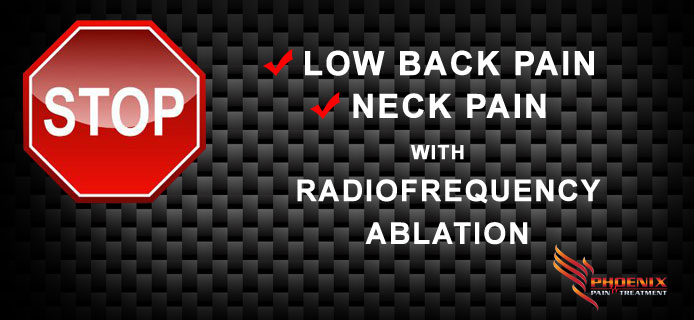RADIOFREQUENCY ABLATION (RF) is a procedure for treating spinal pain created at the joint level of the spine called facet joints. RADIOFREQUENCY ABLATION (RF) is also called facet thermal coagulation or rhizotomy.
What are facet joints?
Facet joints or spinal Joints hinge the bones of the spine (vertebrae) together allowing movement at each level of the spine. They are like your universal joints of your spine when you move. Your facet joints are present on both sides of the spine. These universal or facet joints are about the size of your thumbnail in the low back area and as you go upwards towards the neck they become the size of your little finger nail.
Although the facets may seem small they are rich in nerve supply especially from the Medial branch nerves. The median nerves is a direct supply to the facet joint to perceive and report pain from the facet joint. They tell the brain when facet joints have been injured. Each facet joint has two or three medial branch nerves basically from its own level in the spine and one each from the level above and below.
What does facet joint pain feel like?
If your spinal joints are damaged the pain can feel like mild to moderate muscle tension. Other times it can be mild to severe pain. The type of pain you feel is directly related to the type and amount of damage that has taken place in and or around the tissues of your spinal joints. The doctors at Phoenix Pain treatment will access the condition of the cartilaginous lining as well as the ligaments that hold the vertebrae together.
How do I know if I have facet pain?
Typically you will have pain at one to three levels of your spine, lasting longer than two months, you probably have facet pain. X-rays or MRIs are not the best tests to determine your facet or facets are the cause of your back or neck pain. The gold standard to accurately diagnose facet pain is to block the pain signal from your medial branch nerve.
RFA uses radiofrequency energy to disrupt nerve function. When this is done to a medial branch nerve, the nerve can no longer transmit pain from an injured facet joint.
What happens during an RFA?
RFA uses radiofrequency energy to interrupt nerve perception as well as function and therefore the nerve can no longer conduct pain from the source at the facet joint. RFA may start with mild twilight sedation to help you relax. A local anesthetic is used to numb your skin. The doctor will then insert a thin needle near the facet joint guided by either ultra sound or a special moveable x-ray machine called a Fluoroscope. To make sure the doctor is at the correct level he will first stimulate the nerve very mildly, which may cause muscle twitching and slightly increasing your pain. Then once we know we are at the exact level of the guilty nerve it is numbed. Radiofrequency is really diagnostic as well as therapeutic and typically performed at one to three levels of the spine as well as on each side of the spine.
What happens after RFA?
We keep an eye on you for about an hour following a RF procedure primarily because of the mild twilight sedation. Upon discharge you will receive specific discharge instructions. Some patient opt to not have sedation and about half opt for the twilight sedation. The twilight sedation is elective and up to you so if you do elect to have twilight sedation you will have to have a designated driver to drive you home. If you do not have the sedation you will be allowed to drive home but we suggest you still get a designated driver just to be extra safe.
Typically you will have soreness for up to four days. This is completely normal. This is more than likely due to muscle and nerve irritation. You may feel numbness, slight weakness, and sometimes an itchy feeling for a few weeks. Full pain relief normally comes in two to three weeks.
How long can I expect pain relief?
Amazingly your nerve tissue can regenerate after a Radiofrequency ablation, but everybody regenerates at different rate or speed. However, pain may or may not return when the nerves regenerate. If it does, another RFA can be done.

